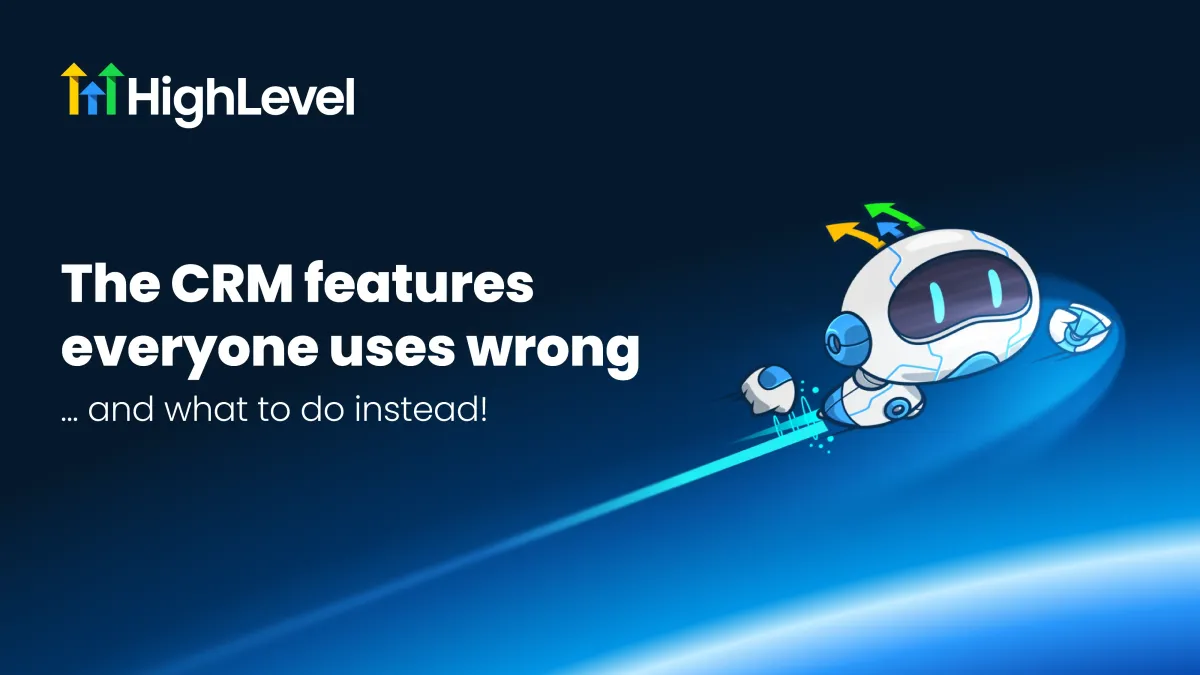
The CRM features everyone uses wrong... and what to do instead!
Almost every business has a CRM today, but few are getting its full value.
According to Digital Silk, 43 percent of CRM users only use half of the features available to them, and research from Adalo shows that less than half of companies reach strong user adoption levels.
In other words, most teams have the technology… they just aren’t using it the right way.
Tags pile up without structure. Pipelines stall. Follow-up automations feel robotic. Lead scores become numbers no one understands.
Sound familiar?
In this guide, we’ll explore:
The most commonly misunderstood CRM features (and how to fix them).
Real-world examples of CRM best practices that drive growth.
How HighLevel CRM simplifies automation and lead tracking.
And the mindset shift that turns a CRM from a database into a revenue engine.
By the end, you’ll know exactly how to stop making the same mistakes most teams do and start using your CRM to actually close deals!
Why most users miss the real power of their CRM
CRMs were built to make life easier, but somewhere along the way, they became complicated.
Teams often use them as digital filing cabinets instead of sales engines, storing data instead of driving results.
The biggest mistake? Treating your CRM as a place to record activity, not automate it.
A CRM should tell your team:
Who to talk to.
When to follow up.
What to say.
And how close each contact is to becoming a customer.
When it’s used correctly, the CRM becomes the heartbeat of your sales and marketing system, connecting outreach, automations and analytics in one continuous workflow.
So let’s break down the four CRM features everyone uses wrong and what to do instead.
Feature #1: Contact tags | More than just labels
Tags are one of the simplest CRM features and also one of the most misused.
Most users treat tags like stickers: they keep adding them without a plan.
“Interested,” “Hot Lead,” “Called Twice,” “Follow-Up Needed”, within months, your CRM looks like a junk drawer of random notes.
What to do instead: build a tagging strategy
Tags are only powerful when they mean something.
To make them work, follow three simple CRM best practices:
Define your tag categories, such as lead source, engagement level and customer type.
Keep it consistent, if one person tags “Webinar Lead,” another shouldn’t tag “WebinarSignup.” Standardize naming conventions.
Use automations to add and remove tags, don’t rely on manual tagging. Let workflows update tags based on actions like form submissions, replies or purchases.
In HighLevel’s CRM, automated tags are easy to set up inside workflows, so your database stays organized without manual cleanup.
Done right, tags become dynamic signals, not static labels.
Feature #2: Pipelines | Where sales usually go to die
A CRM pipeline should visualize momentum, how deals move from interest to close. But for most teams, it turns into a graveyard of “stuck” opportunities.
Leads pile up in one stage. Follow-ups are missed. Deals stall because no one knows who owns the next step.
What to do instead: automate your pipeline movement
Pipelines only work when they’re tied to actions. In HighLevel, you can automate movement between stages:
Move a deal from “Discovery” to “Proposal Sent” when an email is opened.
Trigger a follow-up task after 3 days of no response.
Send reminders when a deal sits idle too long.
This is CRM workflow optimization in action.
It eliminates guesswork, keeps deals flowing and gives your team visibility into what’s working and what’s not.
Feature #3: Lead scoring | Guesswork isn’t a strategy
Lead scoring is one of the most misunderstood CRM features.
Most users assign arbitrary points, 10 for a form submission, 5 for a click, 20 for a meeting and then ignore the scores completely.
Lead scoring without automation or CRM intelligence eventually just turns into noise.
What to do instead: align lead scores with intent
A modern lead scoring CRM should measure engagement and readiness. That means tracking behaviors that actually predict conversion, not just activity.
In HighLevel’s CRM, you can set up scoring based on:
Replies to messages.
Booking a call or meeting.
Visiting a pricing page.
Time spent in a funnel.
You can then trigger actions automatically once a contact crosses a certain score, for example, alerting a sales rep or moving them into a “hot lead” nurture sequence.
That’s where AI CRM tools become powerful. They help interpret patterns and refine scoring models over time, so your sales team focuses on the right leads at the right time.
Feature #4: Follow-up automations | Personalize or perish
Follow-ups are where most deals are won or lost.
Yet 44 percent of salespeople give up after just one follow-up, while most prospects convert after five or more touches.
The problem? Bad automation.
Generic templates, poor timing and tone-deaf sequences make follow-ups feel robotic instead of relevant.
What to do instead: personalize with purpose
Follow-up automation doesn’t mean sending more messages; it means sending smarter ones.
A few CRM best practices can make a huge difference:
Use dynamic variables: Address people by name, reference their inquiry or mention the service they asked about.
Add conditional logic: If a lead clicked a link, send them deeper content. If they didn’t, resend with a different subject line.
Mix channels: Combine email, SMS and even voicemail drops for multi-touch engagement.
HighLevel’s CRM makes this easy with visual workflow automation.
You can design follow-up journeys that branch based on lead behavior, ensuring every contact receives the right message at the right time.
How HighLevel makes it easy to use CRM features the right way
Most CRMs require you to duct-tape separate systems for email, automation and analytics.
HighLevel simplifies it.
Everything, from contact tags to pipelines and lead scoring, works together natively.
Here’s how it fixes the most common CRM mistakes to avoid:
Smart tagging: Automatically apply and remove tags through workflows, keeping your database clean and accurate.
Pipeline automation: Trigger deal updates, reminders and notifications based on real-time activity.
Intelligent scoring: Use behavioral data to prioritize high-intent leads instantly.
Personalized follow-ups: Create multi-channel journeys with Content AI to generate relevant, on-brand messaging.
Add AI CRM tools like Workflow AI and Content AI and you can generate workflows, emails and follow-up scripts in minutes. All aligned with your sales process.
The result? A CRM that doesn’t just store data but acts on it.
CRM features explained: the right way to think about them
When teams finally start using CRMs correctly, they see results fast:
Higher close rates because no lead gets lost.
More productivity thanks to automation that removes manual work.
Better forecasting with real-time data on deal velocity and conversion.
In other words, the CRM becomes the foundation for predictable revenue.
Conclusion: stop misusing your CRM and start closing more deals
Every CRM feature, such as tags, pipelines, scoring and automations, exists to help your team work smarter, not harder.
If yours feels messy, overwhelming or underperforming, it’s not broken. It just needs structure.
That’s where HighLevel’s CRM shines. It turns disconnected tools into a unified system that simplifies your workflow and amplifies your results.
Ready to see how it works? Start your free 14-day trial of HighLevel today and experience what happens when a CRM is set up the right way, for growth, for clarity and for the long run.
Want to take it further? You can also white-label HighLevel to offer powerful CRM automation to your clients under your own brand. Because once you start using your CRM right, everything else gets easier!
FAQs
What are the most underused features in a CRM?
Tags, pipelines, lead scoring and automated follow-ups are often underused or misconfigured. HighLevel helps users automate and optimize each of these for real impact.
Why is my CRM not improving my sales process?
Most CRMs fail because they aren’t tied to workflows. A well-configured CRM automates outreach, tracking and reporting, turning static data into active insights.
How can I fix my broken CRM workflows?
Simplify. Remove redundant automations, standardize your tags and pipelines and rebuild workflows around measurable actions.
What’s the right way to use lead scoring?
Focus on intent. Score behaviors that predict conversion, not just activity and connect those scores to automated follow-ups or rep alerts.
How do I organize contacts better in my CRM?
Use standardized tags, segment contacts by source or behavior and automate updates instead of managing them manually.
Can AI improve my CRM automation strategy?
Yes. AI tools like HighLevel’s Workflow AI and Content AI can build automations, write follow-up messages and refine your outreach based on data trends.
How do I avoid follow-up fatigue in my CRM?
Balance timing and tone. Automate personalized, behavior-based follow-ups instead of sending mass messages.
Which CRM features drive the highest ROI?
Automation, pipeline tracking, lead scoring and personalization consistently produce the best return on investment for small businesses and agencies.

